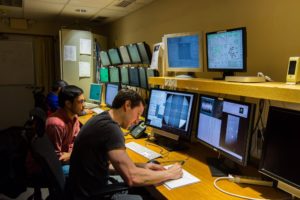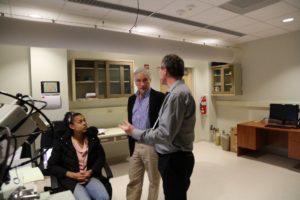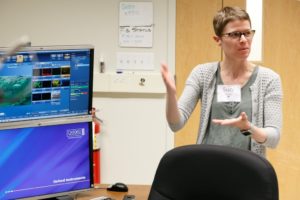
- This event has passed.
Tour of Carnegie Institution for Science Broad Branch Road Laboratories
June 17, 2017 @ 9:30 am - 2:30 pm
 The Carnegie Institution for Science invites DCSWA members on an exciting and exclusive tour of their Broad Branch Road (BBR) Campus, home of two of six Carnegie Science departments located across the country: the Department of Terrestrial Magnetism and Geophysical Labs. At its inception in 1914, BBR served as a “mission control center” for magnetic survey expeditions and sailing ships that crisscrossed the globe measuring the planet’s magnetic field, as well as early materials research on glass and fuses. Today it is an interdisciplinary research center for the Earth and planetary sciences, as well as high-pressure physics. It is home to more than 40 labs and over 100 staff and visiting scientists, postdocs, and technical specialists, plus a library that holds 10,000 technical books, maps, and reports.
The Carnegie Institution for Science invites DCSWA members on an exciting and exclusive tour of their Broad Branch Road (BBR) Campus, home of two of six Carnegie Science departments located across the country: the Department of Terrestrial Magnetism and Geophysical Labs. At its inception in 1914, BBR served as a “mission control center” for magnetic survey expeditions and sailing ships that crisscrossed the globe measuring the planet’s magnetic field, as well as early materials research on glass and fuses. Today it is an interdisciplinary research center for the Earth and planetary sciences, as well as high-pressure physics. It is home to more than 40 labs and over 100 staff and visiting scientists, postdocs, and technical specialists, plus a library that holds 10,000 technical books, maps, and reports.
In this tour, see scientists demonstrate the performance of modern seismometers and show how they can be deployed in the field; demonstrate how astronomers can use a telescope to observe distant planets; see the multi-million-dollar mass spectrometers and ion probes used to analyze and age date rocks from Earth and space; and take a look at the teeny tiny Carnegie logo that was “drawn” on a sample using a scanning electron microscope.
When: Saturday, June 17, 2017, 9:30 am to 2:30 pm
Where: Carnegie Institution, 1530 P St NW (meeting point) and Broad Branch Road campus (5241 Broad Branch Rd NW)
Cost: Free (plus breakfast and lunch included!)
Registration: Register here.
Questions: email Lauren Lipuma at president@dcswa.org.
Details:
The day will start off with breakfast in our beautiful, historic landmark headquarters building nestled between Dupont Circle and Logan Circle. In addition to breakfast, attendees will get a brief video welcome from Carnegie Science President and historian in our state-of-the-art, 385 person lecture hall.
After breakfast, attendees will be transported to the Broad Branch Road campus in Rock Creek Park, where they’ll visit seven laboratories and see demonstrations of the amazing science done at BBR.
Schedule:
9:30 – 9:55 am: Guests arrive at Headquarters Building (1530 P St NW) for breakfast & registration*
9:55 – 10:05 am: Guests watch intro video from President & historian
10:05 – 10:30 am: Guests are transported to BBR campus (5241 Broad Branch Rd NW) via shuttle**
10:30 – 10:35 am: Guests arrive at BBR and are matched with a postdoc tour guide
10:35 am – 12:00 pm: Four lab rotations
12:00 – 1:00 pm: Lunch and refreshments (will include beer and wine)
1:00 – 2:00 pm: Three lab rotations
2:00 – 2:20 pm: Guests are transported back to Headquarters
Tour highlights:
 Seismometers
Seismometers
Several Carnegie scientists are trying to better understand the causes of earthquakes and volcanoes. Seismologist Lara Wagner is also expanding into the world of technology. She is working with a colleague to develop a seismometer package that’s designed for easy placement in the dangerous, and often inaccessible, areas surrounding active volcanoes. This technology also will enable the deployment of the large number of seismometers necessary for making high-resolution images of Earth’s interior using a technique that’s like a medical ultrasound. In this case, however, the source of “sound” is seismic waves from distant earthquakes.
Demonstration:
See Lara Wagner demonstrate the performance of modern seismometers and show how they can be deployed in the field.
 Planet Hunting
Planet Hunting
Carnegie is a hotbed of planet-hunting activity and has been since back when the field was considered desperately uncool. Now exoplanets are everyone’s favorite subject and our astronomers are using multiple tools and methods to find them. It turns out they’re everywhere! But that doesn’t mean planet hunting is easy. It just means there’s more work to do to understand the scope of exoplanet possibilities. But there’s more to planetary science than distant worlds. Scott Sheppard is in close competition to discover our own Solar System’s predicted ninth planet, Planet X. Scott says that a massive object is shaping the orbits of outer Solar System bodies, including the dwarf planet he co-discovered in 2014, nicknamed in honor of then-Vice President Joe Biden, which redefined the Solar System’s edge.
Demonstration:
Watch Scott Sheppard demonstrate how astronomers can use a telescope to observe remotely.
 Space rocks, cosmic dust & super-old rocks
Space rocks, cosmic dust & super-old rocks
Rocks and minerals are full of clues about how our planet was formed and evolved over time, and might even help explain the history of the Moon and our whole Solar System! Carnegie Director Rick Carlson studies some of Earth’s most-ancient rocks. Recently, he has found samples of material in rock formations that date back to shortly after Earth’s formation and found remnants of Earth’s ancient crust that has been reworked into “merely really old rocks.” Several scientists focus on what meteorites—or rocks from space—can teach us about the Solar System’s earliest days. Meteorites are fragments of larger asteroids, which in turn are remnants of the material that formed Earth and the other rocky planets. Meteoriticist Conel Alexander also studies space dust along with another Carnegie scientist (sometimes using a what they call a “cosmic dust buster” and sometimes using a modified “spy plane”).
Demonstration:
There’s a common wrong impression about geology that the only tool needed is a rock hammer. Rick Carlson will lead a tour of the multi-million-dollar mass spectrometers and ion probes used to analyze and age date rocks from Earth and space.
 Electron Microscopy
Electron Microscopy
Specialist Suzy Vitale operates Carnegie’s Focused Ion Beam-Scanning Electron Microscope. That highly technical-sounding mouthful describes a tool that allows scientists to bombard samples with a beam of ions or electrons, which allows them to visualize and characterize samples with very fine detail, including meteorites and moon rocks. Specialist Emma Bullock operates another sophisticated tool, Carnegie’s Electron Microprobe, which can determine the chemical composition of tiny samples of material without destroying them—a hugely important tool for studying rare materials like space rocks.
Demonstration:
Take a look at the teeny tiny Carnegie logo that was “drawn” on a sample using the FIB-SEM, which demonstrates the fine detail of the instrument’s capabilities.
